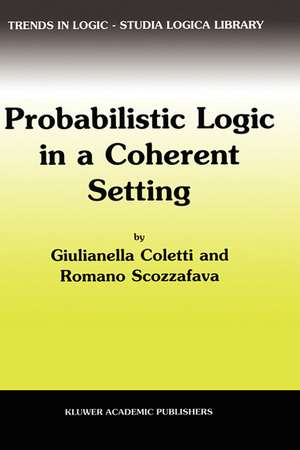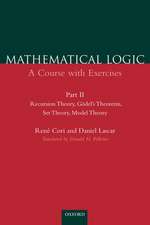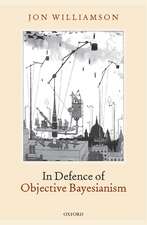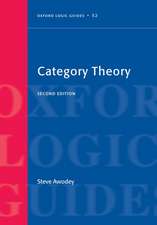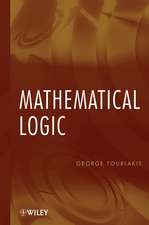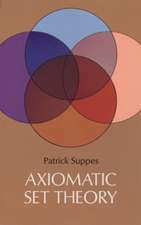Probabilistic Logic in a Coherent Setting: Trends in Logic, cartea 15
Autor Giulianella Coletti, R. Scozzafavaen Limba Engleză Hardback – 31 oct 2002
The book is kept self-contained, provided the reader is familiar with the elementary aspects of propositional calculus, linear algebra, and analysis.
| Toate formatele și edițiile | Preț | Express |
|---|---|---|
| Paperback (1) | 698.30 lei 43-57 zile | |
| SPRINGER NETHERLANDS – 31 oct 2002 | 698.30 lei 43-57 zile | |
| Hardback (1) | 646.75 lei 43-57 zile | |
| SPRINGER NETHERLANDS – 31 oct 2002 | 646.75 lei 43-57 zile |
Din seria Trends in Logic
-
 Preț: 365.81 lei
Preț: 365.81 lei -
 Preț: 361.11 lei
Preț: 361.11 lei - 18%
 Preț: 1225.48 lei
Preț: 1225.48 lei - 18%
 Preț: 959.50 lei
Preț: 959.50 lei - 15%
 Preț: 646.94 lei
Preț: 646.94 lei - 15%
 Preț: 641.85 lei
Preț: 641.85 lei - 18%
 Preț: 1387.73 lei
Preț: 1387.73 lei - 15%
 Preț: 644.82 lei
Preț: 644.82 lei - 15%
 Preț: 636.12 lei
Preț: 636.12 lei - 15%
 Preț: 647.40 lei
Preț: 647.40 lei - 15%
 Preț: 641.03 lei
Preț: 641.03 lei - 18%
 Preț: 733.03 lei
Preț: 733.03 lei -
 Preț: 385.47 lei
Preț: 385.47 lei - 18%
 Preț: 960.42 lei
Preț: 960.42 lei - 18%
 Preț: 956.18 lei
Preț: 956.18 lei - 18%
 Preț: 952.09 lei
Preț: 952.09 lei - 20%
 Preț: 1276.86 lei
Preț: 1276.86 lei - 18%
 Preț: 951.14 lei
Preț: 951.14 lei - 15%
 Preț: 643.00 lei
Preț: 643.00 lei - 15%
 Preț: 644.49 lei
Preț: 644.49 lei - 18%
 Preț: 1845.48 lei
Preț: 1845.48 lei - 18%
 Preț: 953.65 lei
Preț: 953.65 lei - 15%
 Preț: 635.47 lei
Preț: 635.47 lei - 18%
 Preț: 894.79 lei
Preț: 894.79 lei - 24%
 Preț: 1205.41 lei
Preț: 1205.41 lei - 15%
 Preț: 635.80 lei
Preț: 635.80 lei
Preț: 646.75 lei
Preț vechi: 760.88 lei
-15% Nou
Puncte Express: 970
Preț estimativ în valută:
123.76€ • 129.54$ • 103.00£
123.76€ • 129.54$ • 103.00£
Carte tipărită la comandă
Livrare economică 31 martie-14 aprilie
Preluare comenzi: 021 569.72.76
Specificații
ISBN-13: 9781402009174
ISBN-10: 1402009178
Pagini: 300
Ilustrații: IV, 291 p.
Dimensiuni: 155 x 235 x 22 mm
Greutate: 0.59 kg
Ediția:2002
Editura: SPRINGER NETHERLANDS
Colecția Springer
Seria Trends in Logic
Locul publicării:Dordrecht, Netherlands
ISBN-10: 1402009178
Pagini: 300
Ilustrații: IV, 291 p.
Dimensiuni: 155 x 235 x 22 mm
Greutate: 0.59 kg
Ediția:2002
Editura: SPRINGER NETHERLANDS
Colecția Springer
Seria Trends in Logic
Locul publicării:Dordrecht, Netherlands
Public țintă
ResearchCuprins
1 Introduction.- 1.1 Aims and motivation.- 1.2 A brief historical perspective.- 2 Events as Propositions.- 2.1 Basic concepts.- 2.2 From “belief” to logic?.- 2.3 Operations.- 2.4 Atoms (or “possible worlds”).- 2.5 Toward probability.- 3 Finitely Additive Probability.- 3.1 Axioms.- 3.2 Sets (of events) without structure.- 3.3 Null probabilities.- 4 Coherent probability.- 4.1 Coherence.- 4.2 Null probabilities (again).- 5 Betting Interpretation of Coherence.- 6 Coherent Extensions of Probability Assessments.- 6.1 de Finetti's fundamental theorem.- 6.2 Probabilistic logic and inference.- 7 Random Quantities.- 8 Probability Meaning and Assessment: a Reconciliation.- 8.1 The “subjective” view.- 8.2 Methods of evaluation.- 9 To Be or not To Be Compositional?.- 10 Conditional Events.- 10.1 Truth values.- 10.2 Operations.- 10.3 Toward conditional probability.- 11 Coherent Conditional Probability.- 11.1 Axioms.- 11.2 Assumed or acquired conditioning?.- 11.3 Coherence.- 11.4 Characterization of a coherent conditional probability.- 11.5 Related results.- 11.6 The role of probabilities 0 and 1.- 12 Zero-Layers.- 12.1 Zero-layers induced by a coherent conditional probability.- 12.2 Spohn's ranking function.- 12.3 Discussion.- 13 Coherent Extensions of Conditional Probability.- 14 Exploiting Zero Probabilities.- 14.1 The algorithm.- 14.2 Locally strong coherence.- 15 Lower and Upper Conditional Probabilities.- 15.1 Coherence intervals.- 15.2 Lower conditional probability.- 15.3 Dempster's theory.- 16 Inference.- 16.1 The general problem.- 16.2 The procedure at work.- 16.3 Discussion.- 16.4 Updating probabilities 0 and 1.- 17 Stochastic Independence in a Coherent Setting.- 17.1 “Precise” probabilities.- 17.2 “Imprecise” probabilities.- 17.3 Discussion.- 17.4Concluding remarks.- 18 A Random Walk in the Midst of Paradigmatic Examples.- 18.1 Finite additivity.- 18.2 Stochastic independence.- 18.3 A not coherent “Radon-Nikodym” conditional probability.- 18.4 A changing “world”.- 18.5 Frequency vs. probability.- 18.6 Acquired or assumed (again).- 18.7 Choosing the conditioning event.- 18.8 Simpson’s paradox.- 18.9 Belief functions.- 19 Fuzzy Sets and Possibility as Coherent Conditional Probabilities.- 19.1 Fuzzy sets: main definitions.- 19.2 Fuzziness and uncertainty.- 19.3 Fuzzy subsets and coherent conditional probability.- 19.4 Possibility functions and coherent conditional probability.- 19.5 Concluding remarks.- 20 Coherent Conditional Probability and Default Reasoning.- 20.1 Default logic through conditional probability equal to 1.- 20.2 Inferential rules.- 20.3 Discussion.- 21 A Short Account of Decomposable Measures of Uncertainty.- 21.1 Operations with conditional events.- 21.2 Decomposable measures.- 21.3 Weakly decomposable measures.- 21.4 Concluding remarks.
